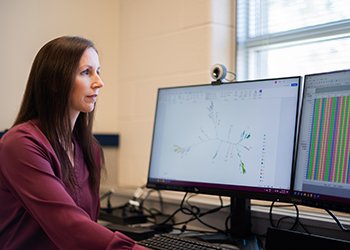Profiles: Researchers take diverse paths to Schulich Medicine

Van Lu, PhD: A clear idea of the future
By Dika Ojiakor
Van Lu and Jennifer Guthrie, both PhDs, are two new faces at Schulich School of Medicine & Dentistry. Take a few minutes to get to know more about their research, their accomplishments, and the different paths they took to get here.
Van Lu, PhD – Following her passion
From an early age, Van Lu, PhD, had a clear idea of what she wanted her future career to be.
“I always liked science experiments, so when I got my first undergraduate experience in the lab, I knew this was the kind of environment I enjoyed working in, and that feeling has stuck with me ever since.”
“I always liked science experiments, so when I got my first undergraduate experience in the lab, I knew this was the kind of environment I enjoyed working in, and that feeling has stuck with me ever since.”
— Van Lu, PhD
But the path to becoming a research scientist, and to choosing a research field to specialize in, was a long one.
During her PhD at the University of Alberta, and afterwards as a postdoctoral fellow at the National Institute of Health in the United States, Lu focused on research topics quite different from the work she now does.
As a PhD student, Lu studied chronic pain mechanisms, using animal models to better understand how external pain signals get to the brain, and how this is perturbed during chronic pain. During her postdoctoral fellowship, she got much more interested in the molecular mechanisms underlying various forms of cell signaling and used molecular tools to manipulate complex signaling pathways.
But when she became interested in an entirely different field of research, she was not afraid to follow her passion, even though this meant switching research fields and moving continents.
Lu went on to do a second postdoctoral fellowship at the University of Cambridge in the U.K., where she studied enteroendocrine cells – specialized cells involved in the gut’s response to external stimuli. Though a seemingly unrelated scientific field, Lu found that she was able to transfer her knowledge and expertise from her prior research environments to the work she now did.
In 2021, Lu joined the Department of Physiology and Pharmacology at Schulich Medicine. She and her team now conduct research to better understand the impact of enteroendocrine cells, as well as some other cell types found in the gut, in the body’s response to nutrients in health and disease conditions.
To study how these cells function in the body, Lu and her team are using new cellular models, including intestinal organoids or mini guts, which involve growing intestinal cells in a petri dish to recapitulate the complex cellular organization found within the gut.
“There's still a lot we don't know about how these cells function, and that's why these new models are interesting to us,” she said. “It allows us to test different drugs and interrogate underlying mechanisms of disease. If we generate organoids from a biopsy sample of an Inflammatory Bowel Disease [IBD] patient, we can interrogate how their intestinal cells are different from those of a normal patient. It's a very neat model that we're exploring and using a lot in our research.”
Jennifer Guthrie, PhD – Research in an emerging field
When the COVID-19 pandemic thrust the world into a state of uncertainty, Jennifer Guthrie, PhD, who was working as an Infectious Disease Researcher at Public Health Ontario at the time, shifted her research into understanding the spread of the deadly virus. Her efforts contributed to the establishment of one of the first programs to sequence the COVID-19 genome in Ontario.
 Jennifer Guthrie, PhD: Research in an emerging field
Jennifer Guthrie, PhD: Research in an emerging field
“The first thing we did was to establish a routine sequencing for surveillance of the virus. And with that, we were better able to understand what was going on with transmission of the disease: the who and where and how of it,” she said.
Guthrie and her colleagues used a variety of genomic and epidemiological tools to monitor new variants of SARS-CoV-2 and establish that people were still able to get infected with the virus even after vaccination.
“Genomic epidemiology allows us to understand how the virus is moving: In what populations, what risk factors, and the role the vaccine plays in preventing transmission,” she said.
“If we can use genomic epidemiology to predict the outbreak and spread of pathogens, without having to grow it in the lab to test its resistance to certain antibiotics, this can give us weeks of potentially correct treatment more quickly.” — Jennifer Guthrie, PhD
Now an Assistant Professor cross-appointed in the Department of Microbiology & Immunology and the Department of Epidemiology & Biostatistics, both at Schulich Medicine, Guthrie’s research focuses more broadly on infectious diseases of public health concern, including COVID-19 and tuberculosis. Her lab uses a wide range of tools, ranging from bioinformatics to genomics, to interpret complex pathogen data and understand the spread of harmful pathogens.
However, Guthrie’s path to becoming a research scientist specializing in infectious disease was not always straightforward.
“I originally started in a basic research laboratory, doing molecular microbiology during my undergraduate and masters studies,” said Guthrie, who arrived at Schulich Medicine earlier this year.
After her masters, Guthrie grew more interested in applied research, first leading her to join a laboratory at Public Health Ontario and then to completing a PhD at the British Columbia Centre for Disease Control (BCCDC) in the new and emerging field of genomic epidemiology.
Guthrie believes her research, which uses new technologies to understand the outbreak and transmission of infectious diseases, can help to limit the spread of harmful pathogens like SARS-CoV-2, as well as offer improved treatments in the future.
“If we can use genomic epidemiology to predict the outbreak and spread of pathogens, without having to grow it in the lab to test its resistance to certain antibiotics, this can give us weeks of potentially correct treatment more quickly. This is one of the central focuses of our research,” she explained.









